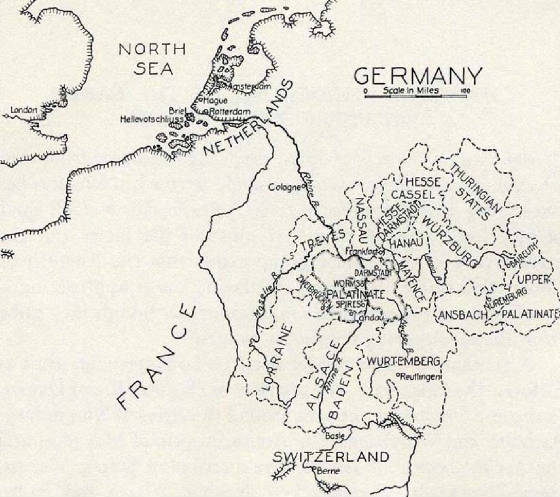How we all got here...
Genealogy is the
account of the descent of a person or family from an ancestor or ancestors. I will attempt to give the account of my
descent and will start with some general information regarding my family. On both the paternal and maternal side of
my family there is German and Scottish/Irish heritage. My paternal and maternal German ancestors arrived in America
during the first half of the 18th century from a region near the Rhine River. Also, at least one of my
Scottish/Irish ancestors arrived in America during the first half of the 18th century from Donegal County, Ireland.
The German immigrants were known as Palatines because the majority of them came from the
Palatinate. The palatinate was a territory administered by a count palatine, originally the direct representative of
the sovereign, but later the hereditary ruler of the territory subject to the crown's overlordship. The German Palatinate
was a region along both the east and west side of the upper Rhine River and part of the Holy Roman Empire. One author
has stated that the Palatinate
[f]rom the thirteenth century
to the close of the eighteenth . . .
maintained a varying importance among the continental powers.
Its boundaries were changeable with the shifting fortunes
of
diplomacy and war. Situated between the greater and rival powers
of France and the German princes, its soil was the frequent
path of
armies and field of battle . . . There were, in fact, two Palatinates --
distinguished as the Upper, or Bavarian, Palatinate, and the
Lower,
or Palatinate of the Rhine -- or Pfalz . . . . [The boundaries of the Lower
or Rhenish Palatinate] may be somewhat vaguely stated as the states of
Mainz, Treves, Lorraine, Alsace, Baden, and Wurtemberg; boundaries
subject
to more or less of expansion and contraction, according as one
or the other of its little provinces became the spoil of war.
Sandford H. Cobb, The Story of the
Palatines: An Episode in Colonial History (A Facsimile Reprint), Heritage Books, 2006, pp. 20-21. There was
a mass emigration from the Palatinate and neighboring territories during the 17th and 18th centuries primarily because
of "the long history of warfare, indeed the southwest German-speaking realm may be referred to as a war zone."
The area of emigration which is shown in the map set forth below encompassed an area along
the Rhine River from Basel to Colonge. It also included the tributaries of the Rhine, the Mosel (Mosselle in French)
on the west and the Main and Neckar on the east, and the district of Zweibrucken which bordered Lorraine on the north.


